Frictionless Motion of Diffuse Interfaces by Sharp Phase-Field Modeling
Abstract
:1. Introduction
2. Methods
2.1. The Sharp Phase Field Method (SPFM)
2.2. Contact Angle Boundary Conditions
2.3. Measure of the Interface Position and Width
3. Results and Discussion
3.1. Frictionless Interface Motion in 1D
3.2. Frictionless Interface Motion in 3D
3.3. Interface Energy-Driven Shape Relaxation
3.4. Potential Computational Gains
4. Conclusions
- Spurious grid friction is studied by means of simulations of stationary interface motion in one dimension, as shown in Figure 7. In the limit of small driving forces, all CF models are limited by grid pinning, while the sharp phase-field model is entirely free of this effect. With respect to the important case of large dimensionless driving forces, all models involving the natural interpolation function are limited by the condition of phase stability. The other models are limited by spurious grid friction due to increasingly stronger alternations of the phase-field profile.
- The residual kinetic anisotropy of the models is evaluated by systematic variations of the interface orientation within the 3D simulation of the constantly driven interface motion. When imposing a one-grid-point interface resolution (as small as a high degree of kinetic isotropy) can only be obtained by employing models, which locally restore translational invariance (TI) in the local direction of interface motion. The global restoration of TI in fixed directions provides substantial kinetic anisotropies already at dimensionless profile resolutions of , as shown in Figure 8.
- The residual anisotropy of the interfacial energy is evaluated by means of a shape relaxation simulation of one initially cubic particle in a system under the constraint of a constant particle volume. Figure 9 shows the evaluation of the sphericity of the quasi-equilibrium particle shapes as a function of the phase-field profile resolution for different phase-field models. In any case, the different sharp phase-field models provide substantially lower energetic anisotropies as compared to the conventional CF model. However, for profile resolutions below , grid pinning is observed in unlucky cases using models with a global restoration of TI in fixed lattice directions. The TI model reliably provides very small residual interface energy anisotropies.
Supplementary Materials
Author Contributions
Funding
Data Availability Statement
Acknowledgments
Conflicts of Interest
Abbreviations
| SPFM | sharp phase-field method |
| CF | continuum field |
| TI | translational invariance |
| FD | finite difference |
| FFT | fast Fourier transformation |
References
- Debierre, J.M.; Guérin, R.; Kassner, K. Crystal growth in a channel: Pulsating fingers, merry-go-round patterns, and seesaw dynamics. Phys. Rev. E 2013, 88, 042407. [Google Scholar] [CrossRef] [PubMed]
- Bollada, P.C.; Goodyer, C.E.; Jimack, P.K.; Mullis, A.M.; Yang, F.W. Three dimensional thermal-solute phase field simulation of binary alloy solidification. J. Comp. Phys. 2015, 287, 130–150. [Google Scholar] [CrossRef] [Green Version]
- Kurz, W.; Rappaz, M.; Trivedi, R. Progress in modelling solidification microstructures in metals and alloys. Part II: Dendrites from 2001 to 2018. Int. Mater. Rev. 2021, 66, 30–76. [Google Scholar] [CrossRef]
- Tourret, D.; Liu, H.; LLorca, J. Phase-field modeling of microstructure evolution: Recent applications, perspectives and challenges. Prog. Mater. Sci. 2021, 123, 100810. [Google Scholar] [CrossRef]
- Wang, K.; Boussinot, G.; Brener, E.A.; Spatschek, R. Quantitative nondiagonal phase field modeling of eutectic and eutectoid transformations. Phys. Rev. B 2021, 103, 184111. [Google Scholar] [CrossRef]
- Asta, M.; Beckermann, C.; Karma, A.; Kurz, W.; Napolitano, R.; Plapp, M.; Purdy, G.; Rappaz, M.; Trivedi, R. Solidification microstructures and solid-state parallels: Recent developments, future directions. Acta Mater. 2009, 57, 941–971. [Google Scholar] [CrossRef] [Green Version]
- Wang, Y.; Li, J. Phase field modeling of defects and deformation. Acta Mater. 2010, 58, 1212. [Google Scholar] [CrossRef]
- Jokisaari, A.; Naghavi, S.; Wolverton, C.; Voorhees, P.W.; Heinonen, O. Predicting the morphologies of γ’ precipitates in cobalt-based superalloys. Acta Mater. 2017, 141, 273–284. [Google Scholar] [CrossRef]
- Mianroodi, J.; Shanthraj, P.; Kontis, P.; Cormier, J.; Gault, G.; Svendsen, B.; Raabe, D. Atomistic phase field chemomechanical modeling of dislocation-solute-precipitate interaction in Ni-Al-Co. Acta Mater. 2019, 175, 250–261. [Google Scholar] [CrossRef]
- Mianroodi, J.R.; Shanthraj, P.; Svendsen, B.; Raabe, D. Phase-Field Modeling of Chemoelastic Binodal/Spinodal Relations and Solute Segregation to Defects in Binary Alloys. Materials 2021, 14, 1787. [Google Scholar] [CrossRef]
- Pons, A.J.; Karma, A. Helical crack-front instability in mixed-mode fracture. Nature 2010, 464, 85. [Google Scholar] [CrossRef] [PubMed]
- Chen, C.H.; Bouchbinder, E.; Karma, A. Instability in dynamic fracture and the failure of the classical theory of cracks. Nat. Phys. 2017, 13, 1186–1190. [Google Scholar] [CrossRef]
- Lubomirsky, Y.; Chen, C.H.; Karma, A.; Bouchbinder, E. Universality and Stability Phase Diagram of Two-Dimensional Brittle Fracture. Phys. Rev. Lett. 2018, 121, 134301. [Google Scholar] [CrossRef] [PubMed] [Green Version]
- Mesgarnejad, A.; Karma, A. Vulnerable window of yield strength for swelling-driven fracture of phase-transforming battery materials. npj Comp. Mater. 2020, 6, 58. [Google Scholar] [CrossRef]
- Yadav, A.; Nguyen, K.; Hong, Z.; García-Fernández, P.; Aguado-Puente, P.; Nelson, C.; Das, S.; Prasad, B.; Kwon, D.; Cheema, S.; et al. Spatially resolved steady-state negative capacitance. Nature 2019, 565, 468–471. [Google Scholar] [CrossRef] [Green Version]
- Moelans, N.; Blanpain, B.; Wollants, P. Quantitative Phase-Field Approach for Simulating Grain Growth in Anisotropic Systems with Arbitrary Inclination and Misorientation Dependence. Phys. Rev. Lett. 2008, 101, 025502. [Google Scholar] [CrossRef] [Green Version]
- Darvishi Kamachali, R.; Abbondandolo, A.; Siburg, K.; Steinbach, I. Geometrical grounds of mean field solutions for normal grain growth. Acta Mater. 2015, 90, 252–258. [Google Scholar] [CrossRef]
- Dimokrati, A.; Le Bouar, Y.; Benyoucef, M.; Finel, A. S-PFM model for ideal grain growth. Acta Mater. 2020, 201, 147–157. [Google Scholar] [CrossRef]
- Ni, Y.; Yu, S.; Jiang, H.; He, L. The shape of telephone cord blisters. Nat. Commun. 2017, 8, 14138. [Google Scholar] [CrossRef] [Green Version]
- Tonks, M.; Aagesen, L. The Phase Field Method: Mesoscale Simulation Aiding Material Discovery. Annu. Rev. Mater. Res. 2019, 49, 79–102. [Google Scholar] [CrossRef]
- Aagesen, L.; Schwen, D.; Tonks, M.; Zhang, Y. Phase-field modeling of fission gas bubble growth on grain boundaries and triple junctions in UO2 nuclear fuel. Comp. Mater. Sci. 2019, 161, 35–45. [Google Scholar] [CrossRef]
- Kim, K.; Sherman, Q.; Aagesen, L.; Voorhees, P. Phase-field model of oxidation: Kinetics. Phys. Rev. E 2020, 101, 022802. [Google Scholar] [CrossRef] [PubMed]
- Gránásy, L.; Rátkai, L.; Tóth, G.I.; Gilbert, P.U.P.A.; Zlotnikov, I.; Pusztai, T. Phase-Field Modeling of Biomineralization in Mollusks and Corals: Microstructure vs Formation Mechanism. JACS Au 2021, 1, 1014–1033. [Google Scholar] [CrossRef] [PubMed]
- Karma, A.; Rappel, W.J. Quantitative phase-field modeling of dendritic growth in two and three dimensions. Phys. Rev. E 1998, 57, 4323–4349. [Google Scholar] [CrossRef] [Green Version]
- Bösch, A.; Müller-Krumbhaar, H.; Shochet, O. Phase-field models for moving boundary problems: Controlling metastability and anisotropy. Z. Phys. B 1995, 97, 367–377. [Google Scholar] [CrossRef]
- Wang, S.L.; Sekerka, R.; Wheeler, A.; Murray, B.; Coriell, S.; Braun, R.; McFadden, G. Thermodynamically-consistent phase-field models for solidification. Physica D 1993, 69, 189–200. [Google Scholar] [CrossRef]
- Kobayashi, R. Modeling and numerical simulations of dendritic crystal growth. Physica D 1993, 63, 410–423. [Google Scholar] [CrossRef]
- Abel, T.; Brener, E.; Müller-Krumbhaar, H. Three-dimensional growth morphologies in diffusion-controlled channel growth. Phys. Rev. E 1997, 55, 7789–7792. [Google Scholar] [CrossRef]
- Echebarria, B.; Folch, R.; Karma, A.; Plapp, M. Quantitative phase-field model of alloy solidification. Phys. Rev. E 2004, 70, 061604. [Google Scholar] [CrossRef] [Green Version]
- Eiken, J.; Böttger, B.; Steinbach, I. Multiphase-field approach for multicomponent alloys with extrapolation scheme for numerical application. Phys. Rev. E 2006, 73, 066122. [Google Scholar] [CrossRef]
- Aagesen, L.; Gao, Y.; Schwen, D.; Ahmed, K. Grand-potential-based phase-field model for multiple phases, grains, and chemical components. Phys. Rev. E 2018, 98, 023309. [Google Scholar] [CrossRef] [PubMed] [Green Version]
- Wang, K.; Boussinot, G.; Hüter, C.; Brener, E.; Spatschek, R. Modeling of dendritic growth using a quantitative nondiagonal phase field model. Phys. Rev. Mater. 2020, 4, 033802. [Google Scholar] [CrossRef]
- Zimbrod, P.; Schilp, J. Modelling of microstructures during in-situ alloying in additive manufacturing for efficient material qualification processes. In Proceedings of the Simulation in Produktion und Logistik 2021: 19. ASIM-Fachtagung Simulation in Produktion und Logistik, Erlangen, Germany, 15–17 September 2021. [Google Scholar]
- Fleck, M.; Pilipenko, D.; Spatschek, R.; Brener, E.A. Brittle fracture in viscoelastic materials as a pattern-formation process. Phys. Rev. E 2011, 83, 046213. [Google Scholar] [CrossRef] [PubMed] [Green Version]
- Bhadak, B.; Sankarasubramanian, R.; Choudhury, A. Phase-Field Modeling of Equilibrium Precipitate Shapes under the Influence of Coherency Stresses. Metall. Mater. Trans. A 2018, 49, 5705–5726. [Google Scholar] [CrossRef] [Green Version]
- Mesgarnejad, A.; Pan, C.; Erb, R.M.; Shefelbine, S.J.; Karma, A. Crack path selection in orientationally ordered composites. Phys. Rev. E 2020, 102, 013004. [Google Scholar] [CrossRef]
- Steinbach, I. Phase-field models in materials science. Modell. Sim. Mater. Sci. Eng. 2009, 17, 073001. [Google Scholar] [CrossRef]
- Steinbach, I. Phase-Field Model for Microstructure Evolution at the Mesoscopic Scale. Annu. Rev. Mater. Res. 2013, 43, 89. [Google Scholar] [CrossRef]
- Cottura, M.; Le Bouar, Y.; Appolaire, B.; Finel, A. Role of elastic inhomogeneity in the development of cuboidal microstructures in Ni-based superalloys. Acta Mater. 2015, 94, 15–25. [Google Scholar] [CrossRef]
- Song, Y.; Tourret, D.; Mota, F.; Pereda, J.; Billia, B.; Bergeon, N.; Trivedi, R.; Karma, A. Thermal-field effects on interface dynamics and microstructure selection during alloy directional solidification. Acta Mater. 2018, 150, 139–152. [Google Scholar] [CrossRef]
- Finel, A.; Le Bouar, Y.; Dabas, B.; Appolaire, B.; Yamada, Y.; Mohri, T. Sharp Phase Field Method. Phys. Rev. Lett. 2018, 121, 025501. [Google Scholar] [CrossRef]
- Glasner, K. Nonlinear Preconditioning for Diffuse Interfaces. J. Comp. Phys. 2001, 174, 695–711. [Google Scholar] [CrossRef] [Green Version]
- Weiser, M. Pointwise nonlinear scaling for reaction–diffusion equations. Appl. Num. Math. 2009, 59, 1858–1869. [Google Scholar] [CrossRef] [Green Version]
- Debierre, J.M.; Guérin, R.; Kassner, K. Phase-field study of crystal growth in three-dimensional capillaries: Effects of crystalline anisotropy. Phys. Rev. E 2016, 94, 013001. [Google Scholar] [CrossRef] [PubMed]
- Gong, T.Z.; Chen, Y.; Cao, Y.F.; Kang, X.H.; Li, D.Z. Fast simulations of a large number of crystals growth in centimeter-scale during alloy solidification via nonlinearly preconditioned quantitative phase-field formula. Comp. Mater. Sci. 2018, 147, 338–352. [Google Scholar] [CrossRef]
- Shen, J.; Xu, J.; Yang, J. A New Class of Efficient and Robust Energy Stable Schemes for Gradient Flows. SIAM Rev. 2019, 61, 474–506. [Google Scholar] [CrossRef] [Green Version]
- Ji, K.; Molavi Tabrizi, A.; Karma, A. Isotropic finite-difference approximations for phase-field simulations of polycrystalline alloy solidification. J. Comput. Phys. 2022, 457, 111069. [Google Scholar] [CrossRef]
- Sakane, S.; Takaki, T.; Aoki, T. Parallel-GPU-accelerated adaptive mesh refinement for three-dimensional phase-field simulation of dendritic growth during solidification of binary alloy. Mater. Theory 2022, 6, 3. [Google Scholar] [CrossRef]
- Eiken, J. Numerical solution of the phase-field equation with minimized discretization error. IOP Conf. Ser. Mater. Sci. Eng. 2012, 33, 012105. [Google Scholar] [CrossRef]
- Fleck, M.; Schleifer, F. Sharp phase-field modeling of isotropic solidification with a super efficient spatial resolution. Eng. Comput. 2022, accepted. [Google Scholar] [CrossRef]
- Fleck, M.; Federmann, H.; Pogorelov, E. Phase-field modeling of Li-insertion kinetics in single LiFePO4-nano-particles for rechargeable Li-ion battery application. Comp. Mater. Sci. 2018, 153, 288–296. [Google Scholar] [CrossRef]
- Fleck, M.; Mushongera, L.; Pilipenko, D.; Ankit, K.; Emmerich, H. On phase-field modeling with a highly anisotropic interfacial energy. Eur. Phys. J. Plus 2011, 126, 95. [Google Scholar] [CrossRef]
- Schleifer, F.; Holzinger, M.; Lin, Y.Y.; Glatzel, U.; Fleck, M. Phase-field modeling of a γ/γ″ microstructure in nickel-base superalloys with high γ″ volume fraction. Intermetallics 2020, 120, 106745. [Google Scholar] [CrossRef] [Green Version]
- Schleifer, F.; Fleck, M.; Holzinger, M.; Lin, Y.Y.; Glatzel, U. Phase-Field Modeling of γ′ and γ″ Precipitate Size Evolution during Heat Treatment of Ni-Base Superalloys, Superalloys 2020; Springer International Publishing: Cham, Germany, 2020; Chapter 49; pp. 500–508. [Google Scholar]
- Ben Said, M.; Selzer, M.; Nestler, B.; Braun, D.; Greiner, C.; Garcke, H. A Phase-Field Approach for Wetting Phenomena of Multiphase Droplets on Solid Surfaces. Langmuir 2014, 30, 4033–4039. [Google Scholar] [CrossRef] [PubMed]
- Diewald, F.; Lautenschlaeger, M.; Stephan, S.; Langenbach, K.; Kuhn, C.; Seckler, S.; Bungartz, H.J.; Hasse, H.; Müller, R. Molecular dynamics and phase field simulations of droplets on surfaces with wettability gradient. Comp. Meth. Appl. Mech. Eng. 2020, 361, 112773. [Google Scholar] [CrossRef]
- Fleck, M.; Brener, E.A.; Spatschek, R.; Eidel, B. Elastic and plastic effects on solid-state transformations: A phase field study. Int. J. Mater. Res. 2010, 4, 462. [Google Scholar] [CrossRef] [Green Version]
- Fleck, M.; Querfurth, F.; Glatzel, U. Phase field modeling of solidification in multi-component alloys with a case study on the Inconel 718 alloy. J. Mater. Res. 2017, 32, 4605–4615. [Google Scholar] [CrossRef]
- Tourret, D.; Karma, A. Three-dimensional dendritic needle network model for alloy solidification. Acta Mater. 2016, 120, 240–254. [Google Scholar] [CrossRef] [Green Version]
- Tourret, D.; Sturz, L.; Viardin, A.; Založnik, M. Comparing mesoscopic models for dendritic growth. IOP Conf. Ser. Mater. Sci. Eng. 2020, 861, 012002. [Google Scholar] [CrossRef]
- Mullins, W.; Sekerka, R. Stability of a Planar Interface During Solidification of a Dilute Binary Alloy. J. Appl. Phys. 1964, 35, 444–451. [Google Scholar] [CrossRef]
- Asaro, R.; Tiller, W. Interface morphology development during stress corrosion cracking: Part I. Via surface diffusion. Metall. Mater. Trans. A 1972, 3, 1789–1796. [Google Scholar] [CrossRef]
- Grinfeld, M. The stress driven instability in elastic crystals: Mathematical models and physical manifestations. J. Nonlin. Sci. 1993, 3, 35–83. [Google Scholar] [CrossRef]
- Kassner, K.; Misbah, C.; Müller, J.; Kappey, J.; Kohlert, P. Phase-field modeling of stress-induced instabilities. Phys. Rev. E 2001, 63, 036117. [Google Scholar] [CrossRef]
- Spatschek, R.; Fleck, M. Influence of stress on interface kinetics. Phil. Mag. Lett. 2007, 87, 909. [Google Scholar] [CrossRef]
- Pilipenko, D.; Fleck, M.; Emmerich, H. On numerical aspects of phase-field fracture modelling. Eur. Phys. J. Plus 2011, 126, 100. [Google Scholar] [CrossRef]
- Moelans, N. A quantitative and thermodynamically consistent phase-field interpolation function for multi-phase systems. Acta Mater. 2011, 59, 1077–1086. [Google Scholar] [CrossRef] [Green Version]
- Moelans, N.; Blanpain, B.; Wollants, P. Quantitative analysis of grain boundary properties in a generalized phase field model for grain growth in anisotropic systems. Phys. Rev. B 2008, 78, 024113. [Google Scholar] [CrossRef] [Green Version]
- Bollada, P.C.; Jimack, P.K.; Mullis, A.M. Towards a Physically Consistent Phase-Field Model for Alloy Solidification. Metals 2022, 12, 272. [Google Scholar] [CrossRef]
- Plapp, M. Unified derivation of phase-field models for alloy solidification from a grand-potential functional. Phys. Rev. E 2011, 84, 031601. [Google Scholar] [CrossRef] [Green Version]
- Ohno, M.; Takaki, T.; Shibuta, Y. Variational formulation of a quantitative phase-field model for nonisothermal solidification in a multicomponent alloy. Phys. Rev. E 2017, 96, 033311. [Google Scholar] [CrossRef] [Green Version]
- Greenwood, M.; Shampur, K.N.; Ofori-Opoku, N.; Pinomaa, T.; Wang, L.; Gurevich, S.; Provatas, N. Quantitative 3D phase field modelling of solidification using next-generation adaptive mesh refinement. Comp. Mater. Sci. 2018, 142, 153. [Google Scholar] [CrossRef]
- Holzinger, M.; Schleifer, F.; Glatzel, U.; Fleck, M. Phase-field modeling of γ′-precipitate shapes in nickel-base superalloys and their classification by moment invariants. Eur. Phys. J. B 2019, 92, 208. [Google Scholar] [CrossRef]
- Lin, Y.Y.; Schleifer, F.; Holzinger, M.; Ta, N.; Skrotzki, B.; Darvishi Kamachali, R.; Glatzel, U.; Fleck, M. Quantitative shape-classification of misfitting precipitates during cubic to tetragonal transformations: Phase-field simulations and Experiments. Materials 2021, 14, 1373. [Google Scholar] [CrossRef] [PubMed]
- Nestler, B.; Wendler, F.; Selzer, M.; Stinner, B.; Garcke, H. Phase-field model for multiphase systems with preserved volume fractions. Phys. Rev. E 2008, 78, 011604. [Google Scholar] [CrossRef] [PubMed]
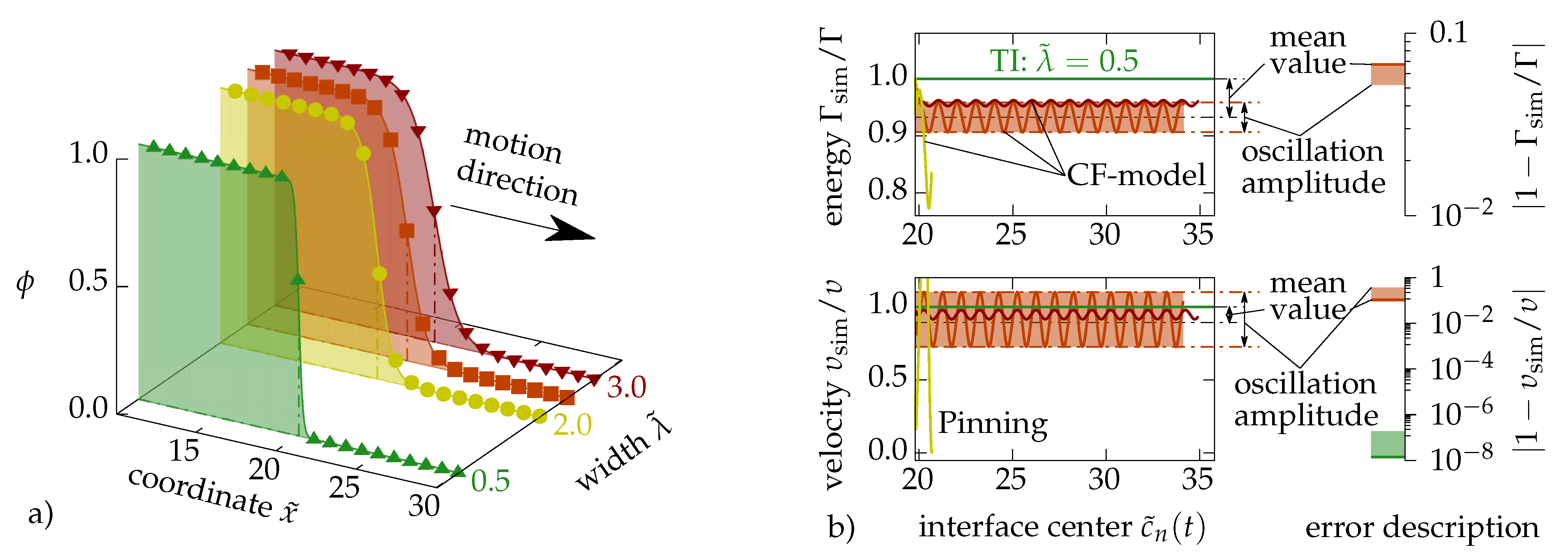

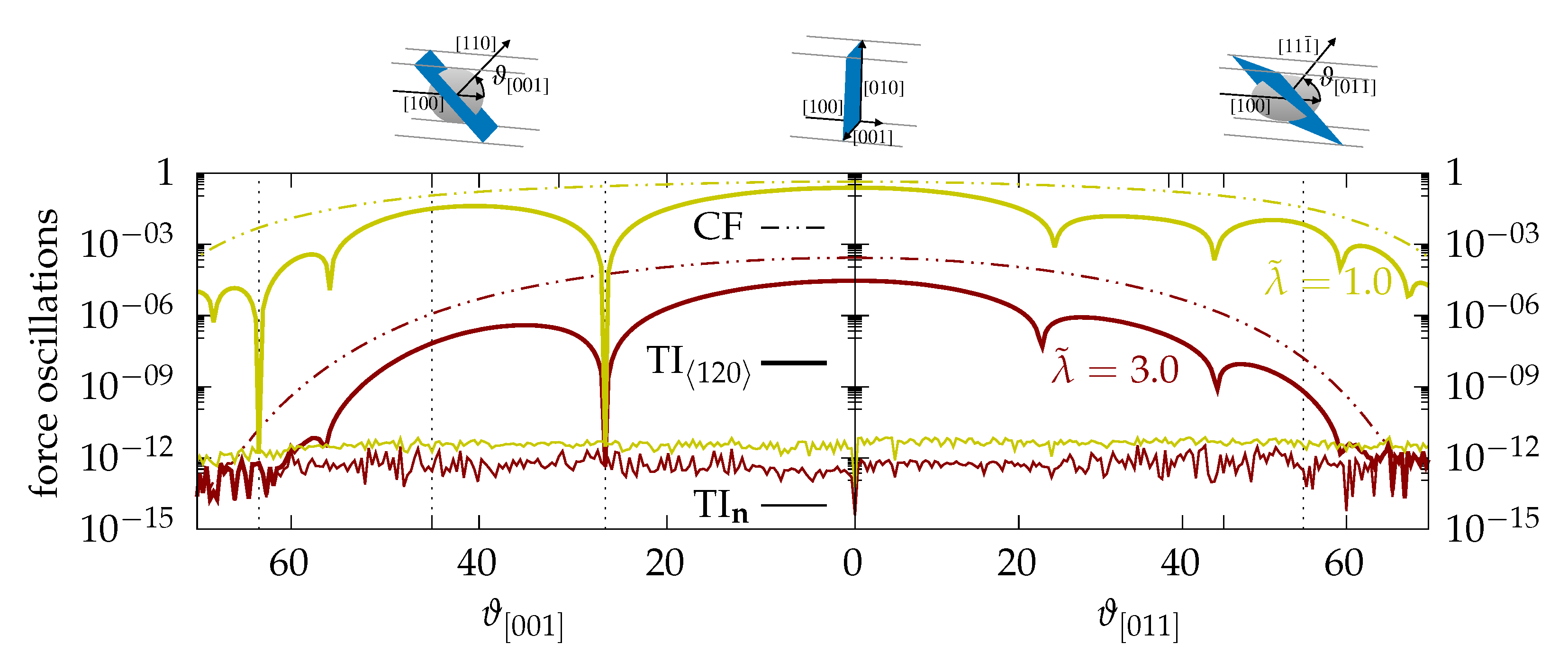

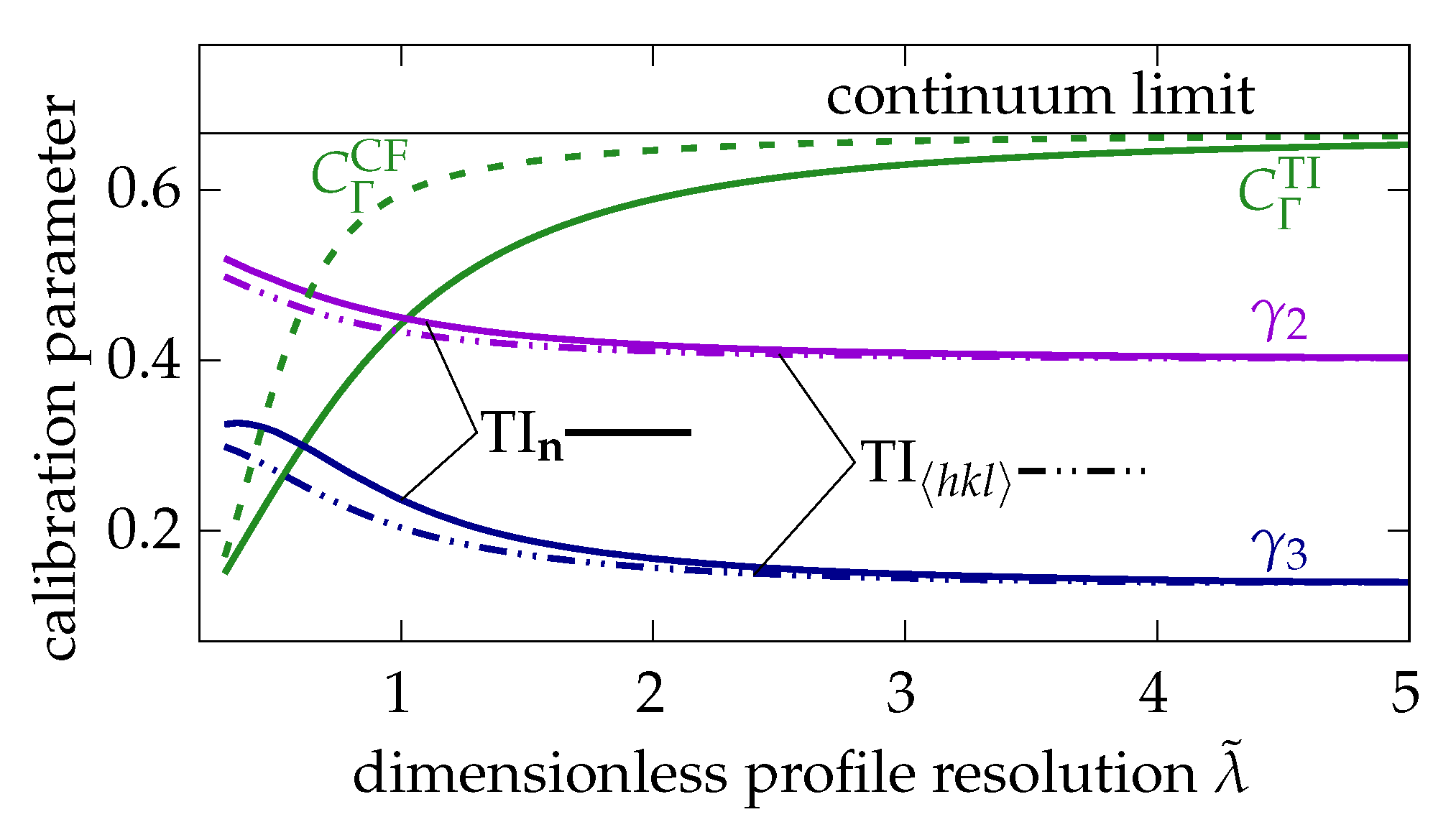

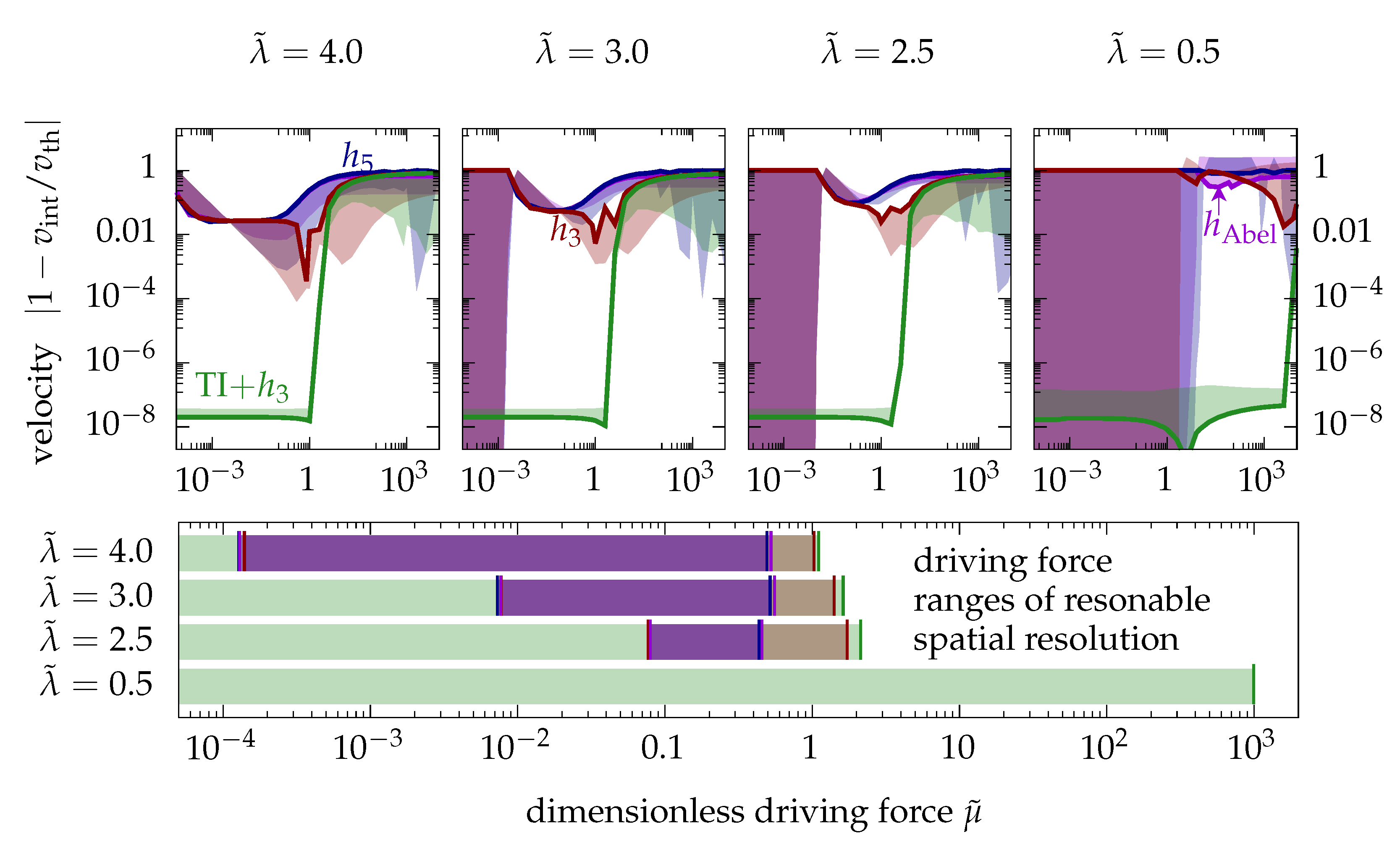
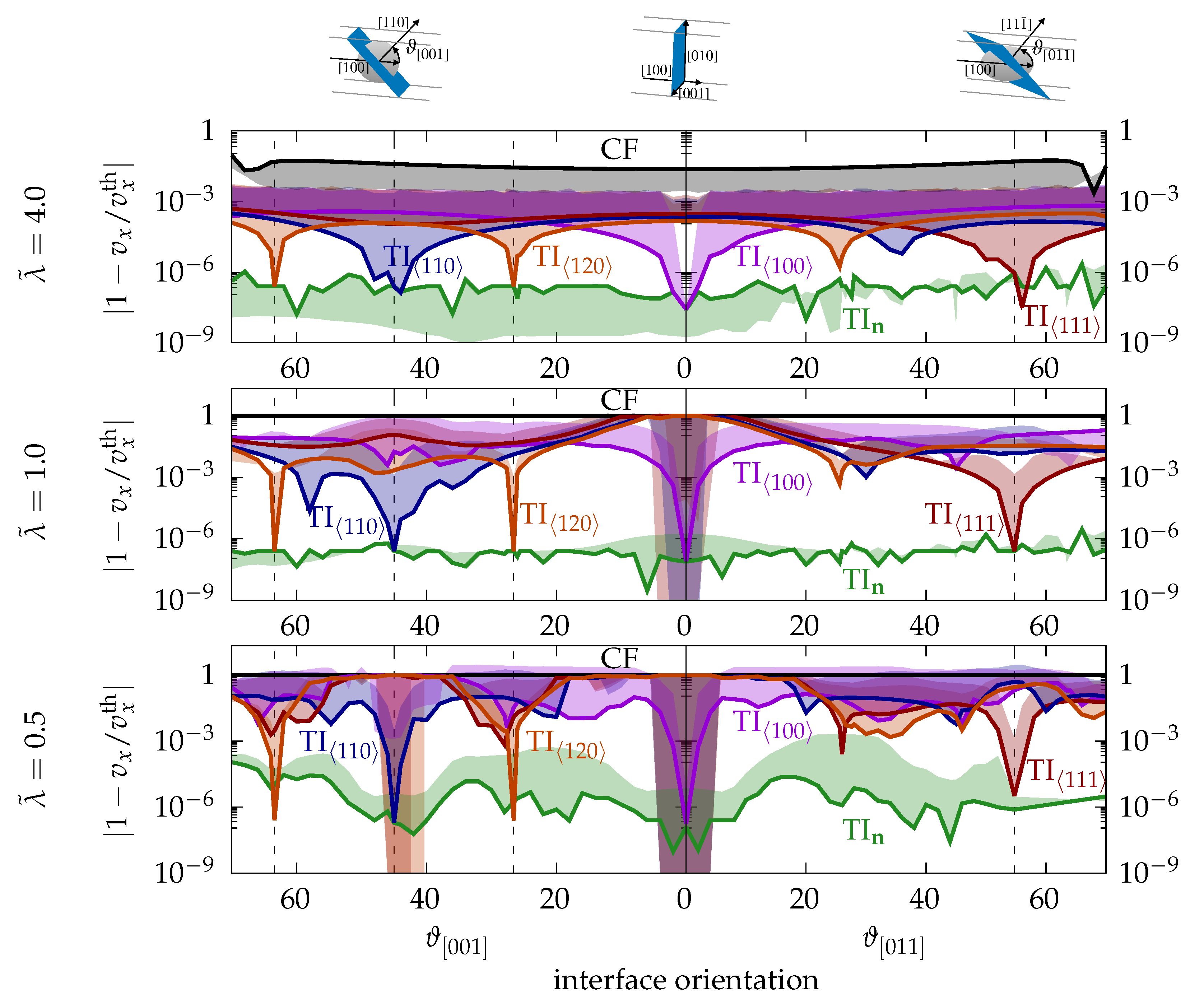

| Shell j | k | p | |||
|---|---|---|---|---|---|
| 1 | 0 | ||||
| 1 | |||||
| 2 | 0 | ||||
| 2 | 3 | ||||
| 4 | |||||
| 5 | |||||
| 6 | |||||
| 7 | |||||
| 8 | |||||
| 3 | 9 | ||||
| 10 | |||||
| 11 | |||||
| 12 |
Publisher’s Note: MDPI stays neutral with regard to jurisdictional claims in published maps and institutional affiliations. |
© 2022 by the authors. Licensee MDPI, Basel, Switzerland. This article is an open access article distributed under the terms and conditions of the Creative Commons Attribution (CC BY) license (https://creativecommons.org/licenses/by/4.0/).
Share and Cite
Fleck, M.; Schleifer, F.; Zimbrod, P. Frictionless Motion of Diffuse Interfaces by Sharp Phase-Field Modeling. Crystals 2022, 12, 1496. https://doi.org/10.3390/cryst12101496
Fleck M, Schleifer F, Zimbrod P. Frictionless Motion of Diffuse Interfaces by Sharp Phase-Field Modeling. Crystals. 2022; 12(10):1496. https://doi.org/10.3390/cryst12101496
Chicago/Turabian StyleFleck, Michael, Felix Schleifer, and Patrick Zimbrod. 2022. "Frictionless Motion of Diffuse Interfaces by Sharp Phase-Field Modeling" Crystals 12, no. 10: 1496. https://doi.org/10.3390/cryst12101496
APA StyleFleck, M., Schleifer, F., & Zimbrod, P. (2022). Frictionless Motion of Diffuse Interfaces by Sharp Phase-Field Modeling. Crystals, 12(10), 1496. https://doi.org/10.3390/cryst12101496








